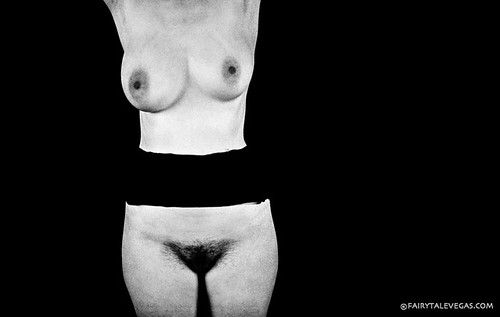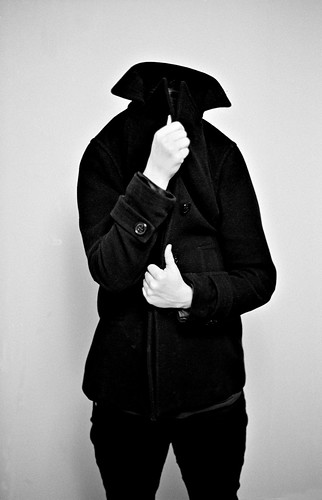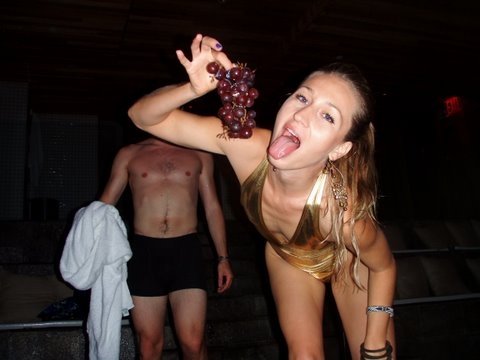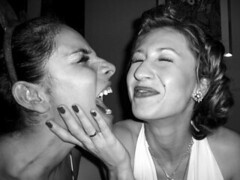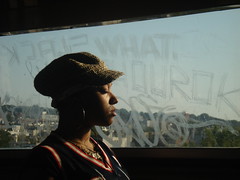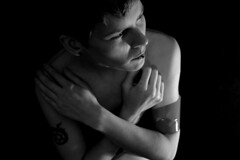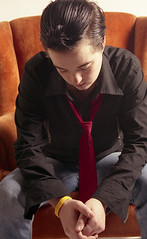Monday, April 19, 2010
Girleye Show response
Thank you for wrapping your superior minds so attentively around this tawdry project. So I think what’s coming together is an awareness of the tension between feminisms. Namely, a contention of how best to address Laura Mulvey’s legacy and the “male gaze”: do we subvert the supposed dominant paradigm by rearranging the organs, or nullify the her mere Freudianism by proliferating the other configurations that had always appeared?
This namely comes to light when A notes that there’s nothing in many of the photographs that indicates authorial gender: “Slowly, we come to understand that it is the essence of the radical (and a slap in the face to both Laura Mulvey and the men whom she rightly criticized) for these photographers merely to portray their subjects with the variegation natural to two (or more) humans playing in the light, linked and loving through a camera lens, and nobody shunned or stopped or subjugated by the process at all.” This is the nullifying side, analogous to moderate feminism, arguing variations of style as genderless. Whereas a radical could say that in order to reveal that such disembodied art inherently oppresses, we must actively pursue unfamiliar forms, we might also claim the paradigm by majority, or reverse the unfamiliar into the canny.
Though not the only strategy, I was drawn sometimes in images to what I knew, not historically specifically, but of the conventional uses of stock photography, the myths it proliferates, and the role of women in generating and managing these images. Part of what I try to get at with “formal queerness” concerns an interest in professional interactions between women. This isn’t necessarily “linked and loving” or without power dynamics and communication errors. It is perhaps related to my interest in understanding what “generic” is to me personally and how it differs from how similar people see it.
So yes, this gets to A’s best point: the collection is regrettably mono-ethnic. It’s unfortunate considering Tribes’s mission of diversity. I’d all too easily turn this into a parody of Stuff White People Like in honest self-defense. I guess I didn’t find any photographers of color, and Marie’s stranger on the subway became a token to highlight the unfair consistency.
To address the other criticism A made, of the subjects’ gender, which she already de-polarized fairly well: the focus of the show narrowed in the making. At first, I was considering photographers of a range of genders, although always addressing feminist issues. Without actually prodding at gender boundaries, we might take femaleness or femininity or whatever the as-opposed-to-what theme is here for granted by limiting it to cisgender. Cassie may have re-titled several photos to negate gender-identified names, hopefully not out of a depersonalizing pressure from me, but to let the androgenous continuum decouple from the models’ names. Even trans men are girls too. My only regret is an accidental exclusion of transwomen.
Perhaps I’m keeping too specific here, and perhaps we’re all happier spared my nitpicking on content and symbol. The show’s faggot-coined shadow title indicates a parodic encouragement of the medium’s (being bodies and cameras and everything that surrounds them) more confrontationally radical interpretations. Yet the actual title is a take on the show-within-the-show (The Girlie Show, sold by the inclusion of a funny black man) on 30 Rock, whose protagonist has lately been the feminist feminists love to hate. Treating a diversification as a simple inversion still invites a complication of the sexual politics involved: Does the subject possess the artist if their autonomy penetrates the lens, as Chavisa suggests? When each image is the evidence of a different reinterpretation of a seemingly limited set of givens, we can see either something only these women could do, or something anyone (or thing!) could do. Is anyone insulted if I’m more excited, and intend more of a compliment, by the second?
Girleye Background by Art Less
Walking into the Girleye show at Tribes unprepared, an ordinary viewer might find herself thinking something like, hmmm, Girleye: Women looking at women. But women look at women all the time. We’re sighted creatures. Duh! And what the heck does ‘girleye’ mean anyway? It’s not a word, people.
Would you care for a little background? Good, because you’re going to get a lot.
The Girleye Show was first ever-so-slyly named after a wrongfully cut scene in John Waters’ 1977 film Pink Flamingoes. Mocking Laura Mulvey a scant two years after the publication of her “Visual Pleasure and Narrative Cinema,” Waters wrote (and later, blaming “all the marijuana I was smoking,” discarded):
A lot of people like cunt, you know. Men, women. But your eyes are like a cunt to me, honey. You can look and look and look...and still I wake up wishing you were there... watching me twenty-four hours a day. Them cunt eyes.
Hilarious, right? Especially if, like John Waters as he wrote the infamous monologue, you have smoked too much marijuana. But whatever does it mean? And how does it relate to the Girleye title? (Another answer, the answer to how the monologue relates to the film from which it was excised will not be given by this blog post primarily because, as the scene has been made available to the public, it does not relate to the rest of Pink Flamingoes at all. How very John Waters, and lovingly so . . . )
First things first. There’s more to the humor here than meets the . . . eye. One suspects that, regardless of the author’s herbal proclivities, he finds the scene funny primarily because he himself is an unreconstructed homosexual. Waters will never find cunt desirable, and he will certainly never wake up wishing two vulvas were staring him down twenty-four hours a day. Moreover, almost all human beings (we can safely extrapolate, but if anyone does scientific research to the contrary, I for one would love to know) would be just the slightest smidge disturbed to see vulvas in the place of eyes on any face—male, female, human, nonhuman; it really doesn’t matter. (Maybe this is why the eye of Sauron squicks us out so?) A cunt for an eye, taken literally, implies a uterus for a brain, and that shit just ain’t genetically viable, so it’s going to squick us out. You can go even further with the visualization and reflect that two tiny cunts correctly positioned under the forehead and above the nose will look not unlike an extremely diseased, shut-swollen, pus-leaking, inflamed and lash-plucked pair of eyes currently visible only on the most destitute Third World beggars, and best avoided in any case if you want to keep your lunch. So it’s funny that anybody, even a John Waters character, would want to see eyes that looked like cunts. And this humor should certainly be kept in mind, and one’s tongue concordantly kept in cheek, as the viewer regards the Girleye selections.
Is there another, more pointed level to the humor? You betcha—it’s one I hinted at earlier, when I mentioned that Waters was mocking Laura Mulvey’s screed “Visual Pleasure and Narrative Cinema”. Mulvey’s whole deal with “Visual Pleasure” was the idea that, in narrative cinema at least, men were necessarily phallic possessive camera-wielding filmmakers and women were necessarily pretty passive vulval looked-at objects, because women didn’t have penises. If women had penises, they’d be potent, but women are born without them, so instead they symbolize castration anxieties. Freud said it, so it’s true. Or thus spake Laura Mulvey.
To review: male looker, female hooker. It totally sucked. But, Mulvey predicted confidently, women didn’t have to worry for too long because narrative cinema was like totally dying out! A narrative film, by the way, is a movie with a story. We can see how well that prediction turned out.
Meanwhile, a whole generation of feminist artists (and writers, and filmmakers, and whatnot) had rightly gotten sick of waiting for their male peers to recognize that women could do technique gud, too. So they chucked it out the window. Technique, that is. The more apologetic of this crowd had a habit of explaining that poorer—no, make that rawer, edgier—technique would a) better show their rage, and b) demarcate them from the tools of the male predecessors and sometime oppressors. In doing so, these artists yielded just about all of their theoretical ground to and via the tool of their male predecessor Marshall McLuhan.
Before we get too snarky here, let’s get something straight. Some of these artists were absolutely brilliant. Personally I have a big fat girl-crush on primitivist sex/art-goddess filmmaker Carolee Schneeman. Back in the sixties, Schneeman liked to film herself getting head from her boyfriend, both elegantly predicting and refuting Mulvey through these sumptuous pieces. (And absolutely no one paid attention, which is why we need shows like Girleye now.)
But most of these radical feminist anti-technique artists were crap. And you can see why. A great idea with a crap presentation is still a great idea, albeit with a crap presentation. At least it’s going to sound good when you tell it to people, even if it sounds better than, sigh, it looks. But a crap idea with crap presentation is doubly crap, or even craptastic. (Footnote: Sometimes I fantasize that a learned speaker will recite a passage such as the above to honor me at my funeral, with a little note of explanation such as, “The crap passage exemplifies the sort of brilliant, and brilliantly subtle, wordplay at which Spitzer excelled”.)
Modern female artists have largely split into two camps—those who continue the tradition of feminist mostly-crap, and those who make beautiful art that is cough, cough, silent on the subject of femininity. Intentionally or not, a silence that reflects a tradition of misogyny all too often propagates that tradition—a tradition which Mulvey, however poor her underlying logic, was perfectly correct to rally against.
But hey. It’s 2010 already.
Remember John Waters’ monologue. The passive cunt becomes an eye: greedy, seeking, it enthralls, sexy in its active power. Let’s reverse our own looking at the text. The figurative made flesh is quite grotesque; the flesh made figurative is . . . fine art . . .
Eye the doubly fine art of Girleye, and enjoy.
Saturday, April 17, 2010
Guest essay - A Girl Eyes "Girleye"
All too often, looking at a collection of fine art “women regarding women” pieces is like inspecting a crèche of Tracy Enim clones. When you’ve seen the Enim originals, you know that this cannot be an easy sight to behold. Perhaps inspired by a collective misreading of Audre Lorde, certain feminist fine artists of the late twentieth century indulged a tendency to chuck out technique in its entirety, with the unfortunate, and predictable, result that many pivotal artworks of that movement come off rather worse in the looking than in the retelling. It is thus with great joy that I report that the photographs in Girleye: Women Looking at Women are by and large gorgeous, but also acutely conscious of sexual politics. (Fiiiiiinally!)
Instead of trouncing technique and tradition by, say, sculpting vulvas out of used car parts and calling them art when the spackle is dry, many of the artists of Girleye have instead chosen to (mis)appropriate the techniques and styles of their most misogynistic forebears for their own, empowered ends. In particular, the young, preternaturally skilled Lauren Goldberg channels the surrealist misogynist Man Ray through her photographs Disconnect and Distance.
That Ms Goldberg has even thought to rework Man Ray instead of, say, posing for him as a model would have constituted, from Man Ray’s or his contemporaries’ points of view, a radically feminist act. Isn’t progress grand?
Meanwhile, the sensitive and gifted Cassie Olander conjures Imogen Cunningham’s Triangles and similar carnal landscapes through her photograph "Unity".
Cunningham was, of course, a woman as well, so the homage initially seems uncomplicated. When the viewer, however, realizes that "Unity" teasingly, almost coyly depicts two nude women locked in a soft embrace, it becomes clear that Olander is repurposing Cunningham’s lauded and, by now, canonical means to send a still unconventional, perhaps radical message.
With LES, Anne Marie Hansen kills her father with rebellious joy and an almost mathematical elegance. The image is simple, powerfully so. A drunk girl in a tacky gold bathing suit dangles a bunch of grapes before her open mouth. The crook of her elbow suggestively obscures the head of a young man standing just behind her. The viewer’s gaze comes to rest on his not-yet-distended swim trunks.
With this image, Ms Hansen lays waste to Magritte, American Apparel ads, real pornography and countless other misogynistic portrayals of women reduced to their capacity as passive sex-recipients . . . by using their motifs and techniques to shoot a message of female sexual hunger straight down our hungry maws. (My father was quick to note that Hansen has reworked surrealist painting The Rape as The Grapes. Let the artist make of this what she may.)
Many other photographs in the set are simply beautiful portraiture. Amanda Palmer (making one of several cameos) has bad sunburn. A pair of nimble clowns practice what looks like acroyoga. Swimmers dot the surf like foam. Progress shows subtly, like light through a lattice. Slowly, we come to understand that it is the essence of the radical (and a slap in the face to both Laura Mulvey and the men whom she rightly criticized) for these photographers merely to portray their subjects with the variegation natural to two (or more) humans playing in the light, linked and loving through a camera lens, and nobody shunned or stopped or subjugated by the process at all. Most of all, that we cannot tell by any trick that these photographers were female is, upon (another) reflection, a most gorgeous happening.
Where, then, the rhymes and reasons to this set? There are many. We can start with the most unsubtle geometry exploited to great effect by the expert artists whose work is featured here—or perhaps, given the show’s very particular theme and patterning, by their curator. To put it bluntly: sexually evocative arcs and swoops and circles, punctuated, or punctured, by the occasional blunt or slender pole, abound in the collection. The vivid plethora of ovoid-and-spike figurings conjure an almost subliminal, spooky mentation reminiscent of Charles Burns’ Black Holes, which turned the vulva-shape into a repeated signifier of horror, a foreshadower of doom nested in appearances of the unexpected—such as a dissected frog’s back, a cut wrist, a lake where children skinny-dip. (Really, if you haven’t read a copy yet, you must—it’s the rare graphic novelist who can make the vulva into a Lovecraftian destroyer of worlds, and absolutely terrify you to pieces with it, and then make you cry.) I leave the viewer to pick his or her own incautious, revelatory path through the darkling bogs and brambles that litter the track of Girleye with a beauty, and a stillness, and danger.
Additionally, and flowing nicely from my bogs’n’brambles metaphor if I do write-so myself, bathing imagery pervades the show. Including the web-only images, roughly one sixth to one seventh of the pieces either allude to bathing or actually feature a nude lady bather or set of bathers. Factor in the joyous lesbian kissing, lesbian sex, and—let’s face it, people—lesbian hairstyles on display in several of the other photographs, and the images of happy women cavorting in water take on a rawer, sexier connotation.
In fact, the show seems to posit the old Radicalesbian message that one of the most authentic ways for women to relate to one another happily as women is by the art of sexual love. In Anne-Marie Hansen’s "Naughty",
a seemingly drunken reveler tilts a frenemy’s chin toward hers in a parody of sexual love, a parody that conceals revulsion. Immediately, for your own psychological wellbeing if for no other cause, contrast this deeply discomfiting (though beautifully done) image with Beth Hommel’s soothing Kiss,
a gentle expression of adoration between women who are real lovers, at least for the moment the camera saw.
Speaking of sex, or politics, or merely the bonds imposed, displaced, ignored or adored by the act of looking: a teasing kind of bondage pervades the images of Girleye. Cassie Olander wraps one subject in a dress of loose bondage tape marked “DANGER”, and another in what looks like a symbolic bracelet of packing tape about the upper arm. Allison Green wraps two nude females against one anther in a web of loose bondage tape that looks a bit like toilet paper or crepe streamers. One thing is clear—these bonds aren’t holding anybody anywhere. Are they jokes, suggestions, denials, teases? On or of the viewer, always—the bondage never holds the subject, in these photos. Greene also photographs two straight lovers turned away from each other in a scarlet bed, a strip of pure white tape pasted across their snuggly bods. The photographer seems to suggest that the bonds—of love, sex, of matrimony, for all we know—that hold these lovers together are as flimsy as the tape she has strewn atop them. (A commentary on the “sanctity” of marriage? Or just of young lusts?)
One rather wishes that curator Janet Bruesselbach’s work had been featured in this show. Indeed, the images seem to have been selected so that, en masse, they resemble one of her massive artworks. With her physics-defying, anatomically incorrect oil orgies and other acts of sly painterly nihilism, Bruesselbach has assembled a career out of teasingly cinching and severing the ties of artist to subject, subject to viewer, male to female, armpit to elbow and whatever else you can think of, always with an eye to disassembling old theory and provoking transformation. The child of two eccentric physicists forever rusticating in one of the more precarious reaches of the rarefied Malibu wasteland, Bruesselbach understands difference with anything but difference, and from more angles than even her most multiply valenced works could invite you, dear Reader, to contemplate.
So it is surprising and perhaps offensive, with all the above dimensions of diversity in mind from both curator and photographers, that all the subjects of Girleye (minus one) are white. One doubts that the artists of Girleye have conspired to constrict the scope of femininity to a single, whitewashed point. Rather, the show evidences by strong implication that the photographers simply don’t hang out with many people who aren’t white. Even Hommel’s Mail Order, a seeming send-up of (Third World, usually nonwhite) mail-order brides, features a white subject as the mailed party. The only actual nonwhite subject in the entire set appears to be a stranger to the photographer (Hansen in this case). Most other subjects meet Ms Hansen’s gaze with ease, evincing familiarity if not friendship. Her lips parted slightly, this subject gazes straight ahead, meditating to the music on her iPod as she wills the subway ride to be over. She appears to be a stranger whom Hansen happened to snap on a long train ride. The image is remarkable for its ordinariness, its emotional opacity. Hansen never knew her subject’s story and, therefore, we viewers will never know it, either.
Another note on difference: one wonders if artist Cassie Olander’s male-presenting subjects Liz and David (and I mean to mark the subject named David especially) would especially desire their images used in a collection of women who are nominally looking at women. The above are also two of the only brooding subjects in the entire show, and their haunted eyes shy from the camera’s shutter, leaving us only with the impression of hunched shoulders and obsessively pomaded hair. Hardly a representative image of butch or—more appropriately—trans moodiness, unless these two just started on their testosterone regimen, in which case, of course, all bets are off (just kidding!). I for one am willing to believe that Ms. Olander accurately captured sad moments in the lives of these two subjects, and from Olander’s other, also beautifully felt work must believe that Olander selected these moments, not to portray transmen as a sad breed generally but to show us the sadness of the falling cherry blossoms, as they happened to fall.
Maybe David and (probably) Liz are not transmen in the first place, but playful young women who happened to butch it up for their respective shoots. Maybe, maybe. But maybe not. What if they are transgendered? What if they really aren’t women? What if they hate the very idea of being included in this show? Well, have I got an interpretation for you.
Noted drag warrior and gender obscurist James St James writes wisely in his novel Freak Show (if you will allow me, dear Reader, to extend and wriggle a bit in this authorial stretch) that the transfolk of our society are trammeled and trashed by the violent misapprehensions of our culture, but the very chains (of thorns or flowers, of iron or of gold) that yoke transfolk into endocultural conflict enable them to act as revolutionary agents, and aching reminders of the impermanence of “fates”.
If this were a slightly academic article and not a (bl)o(g)nanism, I’d write some lameass transition phrase like:
If my interpretation of St James is to be believed, we may celebrate Girleye’s inclusion of transmen—not for the men’s futures qua men, but for the intersection of their futures with their girlish pasts. Or, to misappropriate the oft-appearing Amanda Fucking Palmer, girls will be girls will be boys with no warning. Such transitions imply a potential for our own . . . into boys, into women, into whatever the hell we want, be it sexes or genders or any of the manifold wondrous identities that lie not between our legs but in our lives.
Trans is Latin for across, after all. It would be great if transmen, biowomen, and everyone in between could appreciate the plenitude of identities open to them throughout their lives. And that’s just what this show is for. Let us embrace David, Liz, and all the rest with open arms and mouths and water-forms, and hope that perhaps they like us, too, just a bit at least . . .
On that note, let us close by oh so gleefully misusing a monster quote from that master of misuse, and of potential-play, Donald Barthelme, masquerading here under the voice of a woman impregnated with a fetus by three men—in our interpretation, a woman who becomes us, impregnated with transformative potential by the girls of Girleye:
The engendering force was, perhaps, the fused glance of all of them. From the millions of units crawling about on the surface of the city, their wavering desirous eye selected me. The pupil enlarged to admit more light: more me. They began dancing little dances of suggestion and fear. These dances constitute an invitation of unmistakable import—an invitation which, if accepted, leads one down many muddy roads.
I accepted. What was the alternative?
9
Saturday, April 03, 2010
The Girleye Show
April 3-30, 2010
Tribes Gallery 285 E 3rd St. 2nd Floor NYC 10009
Beth Hommel is a photographer and multimedia artist originally from Vandergrift, Pennsylvania. Her primary focus is the creation of truthful, unusual portraits. Her work has been seen in magazines and newspapers worldwide, and more than a dozen of her photographs were included in Who Killed Amanda Palmer: A Book of Photographic Evidence, which she also designed. She lives in Brooklyn with her partner Kayla.
View more at www.bethhommel.com

Beth Hommel
Before 10 am
16x20
$300

Beth Hommel
Kitchen
11x17
$200

Beth Hommel
Palms & Knees
11x17
$200

Beth Hommel
Ripples II
8x10
$100
Beth Hommel
Murder Was The Case They Gave Me
8x10
$100

Beth Hommel
Fingers Crossed
5x7
$80

Beth Hommel
Mail Order
4x6
$50
Anne Marie Hansen

Anne Marie Hansen
A Soho Sky
11x14
$150

Anne Marie Hansen
Ice
8x10
$150

Anne Marie Hansen
Miss Mercier
8x10
$100

Anne Marie Hansen
Naughty
8x10
$100

Anne Marie Hansen
Beach
5x7
$100

Anne Marie Hansen
Jump Rose
8x10
$100

Ann Marie Hansen
Babeland at 10 am
5x7
$100

Anne Marie Hansen
LES
5x7
$100

Anne Marie Hansen
Katonah Swimmers
8x10
$80

Anne Marie Hansen
F Train
5x7
$100
Anne Marie Hansen
Wedding Day
5x7
$100

Anne Marie Hansen
A Deck of Cards
5x7
$60

Anne Marie Hansen
Lady Lily
5x7
$60
Cassandra Olander resides in Brooklyn, New York and has been a photographer for several years. She has had over 50+ photographs published in Curve, InsideOut, She and GoNYC Magazine, including online features. Her style concentrates on black & white portraiture from a feminist and/or queer perspective. View more at cassandraolander.com

Cassie Olander
Danger
8x10
$125

Cassie Olander
Reaching
8x10
$125

Cassie Olander
Silver
8x10
$125

Cassie Olander
Vulnerability
8x10
$125

Cassie Olander
Contemplative
8x10
$125

Cassie Olander
Reflect
8x10
$125

Cassie Olander
Bubbly
8x10
$125
Lauren Goldberg is photographer based in New York City. Lauren specializes in band and fine art photography. Aside from photography, she works on film and video, as well as graphic design, silkscreen, painting and drawing, and as many other forms of art as possible. She is attending the School of Visual Arts as of Fall 2009 for photography.
Her work is at fairytalevegas.com

Lauren Goldberg
Crying Statue
20x30
$300

Lauren Goldberg
Dismemberment
20x30
$300

Lauren Goldberg
Through the Looking Glass
20x30
$300

Lauren Goldberg
Dead in the Garden
11x17
$250

Lauren Goldberg
Hand
11x17
$200

Lauren Goldberg
Distance
11x17
$200

Lauren Goldberg
Reflection
11x17
$200

Lauren Goldberg
Stairs
11x17
$200
